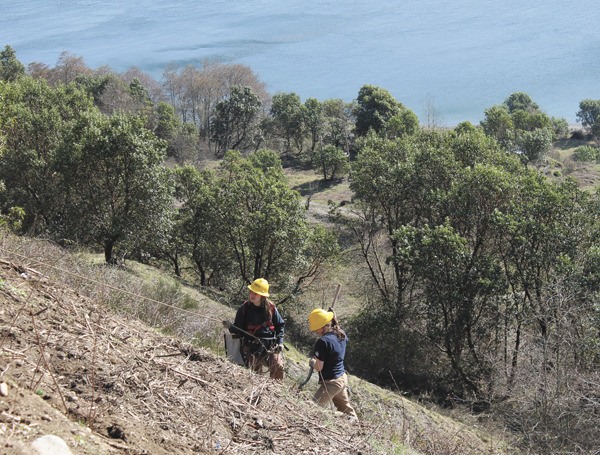On Monday, a crew of five young adults in hard hats and work boots spent the morning balanced on a slope at the Maury Island Marine Park, yanking weeds from the steep hillside and planting native trees and shrubs in their place. From their vantage point near the popular overlook on S.W. 248th Street, the workers could see an open, undulating landscape — the result of five months of labor.
“This whole place was thick with Scotch broom up to a person’s height,” said Brian Massi, who is overseeing the Puget SoundCorps project on Maury and was at the worksite earlier this week. “Now, you can see all the way across. I think it looks a lot better.”
From the hillside down to the shoreline where other crews labored that morning, the brambles that once entangled this popular county park — a 300-acre expanse that features stunning views of the Puget Sound and Mount Rainier — have been largely tackled. Now native trees — cedars, firs and cottonwoods — are prominent at the park, and bright pink flags mark the outline of a new, easier-to-navigate trail that will one day descend from the viewpoint to the beach.
“I think people will really like it,” Massi said.
In October the Puget SoundCorps, a part of the Washington Conservation Corps, began an extensive restoration project at the marine park, a former mining site that King County purchased in the 1980s.
A team of about 25 workers have been there on a near-daily basis, clearing Scotch broom, blackberries and other weeds on 40 acres of the park, their efforts focused mostly on the site’s highly visible mining scar, where sand and gravel were removed and invasive plants have taken hold. They’ve also begun work to double the park’s trail system and recently started the large task of planting 65,000 Douglas fir, alder and cedar seedlings.
“If you look at the site now, you will be in awe,” said Tina Miller, who is coordinating the project through King County’s Department of Natural Resources and Parks. “It’s just amazing what has gotten done. It’s a total transformation of the site.”
The $2.2 million effort on Maury comes by way of a $30 million jobs bill the state Legislature passed in 2011, which included funding for nine Puget SoundCorps projects throughout the region. The marine park is the largest single site to see work by the SoundCorps.
The workers, 18- to 25-year-olds mostly from Tacoma and Seattle, are earning minimum wage for their time and will receive a $5,500 education stipend to use toward either college tuition or repayment of student loans.
The restoration project, believed to be the largest Vashon has ever seen, kicked off last fall with a large press conference and a visit by Public Lands Commissioner Peter Goldmark. At the time, state and county officials expressed cautious optimism about the undertaking, which the Legislature had funded for only one year. The crews would undoubtedly accomplish a lot, they said, but the site would need work beyond one year to assure weeds didn’t take hold again before native plants could grow.
“The young Scotch broom seedlings will come roaring back next year,” said Tom Dean, executive director of the Vashon Maury Island Land Trust and someone paying close attention to the project. “Everyone knows there will be some heavy manpower needed next year.”
But now, nearly halfway into the project, Miller says the outlook is encouraging. For various reasons, the first year of the project will cost only $1 million, not $2.2 million, as originally budgeted. As a result, SoundCorps plans to use the remaining money to fund an additional year of work on Maury, assuming the state Legislature agrees to continue the SoundCorps program.
“It’s highly likely they won’t cut it because the budget is already allocated,” Miller said. “We’re not asking for additional funding.”
Bianca Perla is one islander who will be happy to see the project continue.
Perla, the director of the Vashon Nature Center, and a few local naturalists are organizing volunteers to monitor the thousands of seedlings soon to be planted by the crews. They’ll look to see which ones thrive at the park, where sand, clay and gravel make a difficult environment for young plants. They’ll also experiment with soil amendments and monitor a project to plant madronas — known for being difficult to cultivate — with seeds rather than starts.
“We’re trying to learn something from the project. It’s a pretty challenging site to plant things in,” Perla said.
Dean noted that the lessons learned from the marine park’s restoration could be translated to the former Glacier property, another former mining site King County purchased in 2010 and hopes to one day restore as well.
“It seems like we’re hopefully entering a new wave of restoration in Puget Sound where we’re able to take on bigger and bigger projects,” he said.
Work at the two sprawling natural areas that rise up from the shores of Puget Sound will ultimately help the ailing body of water, Dean said, because of the interplay between an intact shoreline and a healthy marine system.
“Ultimately, that is what’s going to restore Puget Sound,” he said.



